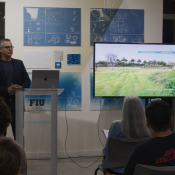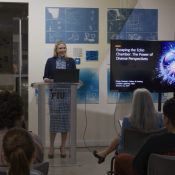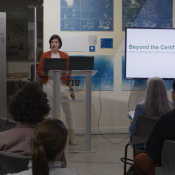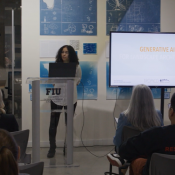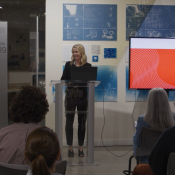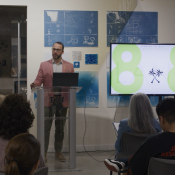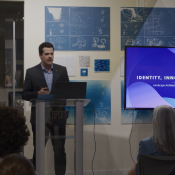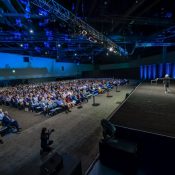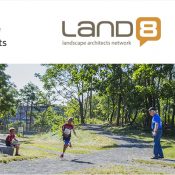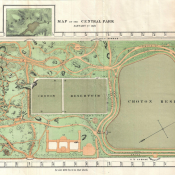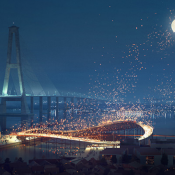Author: Matt Alcide
Design, Art, and the Natural World: Thinking and Being Through Making [Video]
During the Land8x8 Lightning Talks in Miami, landscape architect Roberto Rovira, professor at FIU and principal at Studio Roberto Rovira, shared his profound passion for the natural world, reflecting on the vibrant landscapes and ecosystems of South Florida.
Roberto commenced his talk by highlighting the unique beauty of South Florida’s landscapes, which may lack mountains but boast stunning skies and an irrepressible natural world teeming with life. He shared an inspiring image of a royal poinciana tree outside his studio window, symbolizing the resilience and vitality of nature.
Throughout his presentation, Roberto emphasized the transformative power of landscape architecture, showcasing various projects that merge design, art, and environmental stewardship. One notable project involved engaging communities in creating a landscape using hundreds of zip ties, allowing individuals to leave their mark and shape their environment.
Roberto also discussed the importance of technology in landscape design, particularly his work on the Ecological Atlas, a tool for understanding ecosystem dynamics and visualizing the impact of climate change. By cataloging and organizing thousands of species, the Eco Atlas enables designers to create resilient and sustainable landscapes.
Moreover, Roberto drew inspiration from art, using drawing and other mediums to explore landscapes and ecosystems. He shared examples of his work, including steel plates depicting landscape processes and custom-designed furniture integrated into outdoor spaces.
The presentation concluded with reflections on the beauty and resilience of Florida’s landscapes, despite the challenges they face, such as hurricanes and sea-level rise. Roberto highlighted the importance of embracing and preserving these landscapes, which serve as sources of inspiration and creativity.
Overall, Roberto Rovira’s presentation offered a compelling exploration of the intersection between design, art, and the natural world, emphasizing the role of landscape architecture in shaping sustainable and vibrant environments. Through his projects and insights, Roberto demonstrated the profound impact of thoughtful design on our relationship with the environment.
—
This video was filmed on January 23, 2024 as part of the Land8x8 Lightning Talks sponsored by Anova Furnishings.


Escaping the Echo Chamber: The Power of Diverse Perspectives [Video]
At the Land8x8 Lightning Talks in Miami, Nicole Plunkett, a landscape architect and partner at Cotleur & Hearing, spoke about the importance of diverse perspectives and breaking out of our comfort zones. She is also the founder of Future Landscape Architects of America (FLAA), a non-profit focused on educating K-12 students about the career field of landscape architecture.
Nicole’s presentation centered around her personal experience with a pub trivia team. What started as a casual activity turned into a valuable lesson on the benefits of surrounding oneself with a diverse group of individuals. The team comprised professionals from various fields including interior design, software development, law, healthcare, and engineering, among others. This diversity enriched their knowledge base and made them formidable contenders in the trivia circuit.
The core message of Nicole’s talk was about escaping our echo chambers, those comfortable spaces where we interact with like-minded individuals and are reinforced by similar views and perspectives. In today’s world, technology often reinforces these echo chambers by filtering our exposure to diverse ideas.
Nicole emphasized the importance of embracing different perspectives not just for personal growth but also for professional success. She highlighted how her firm leverages tools like the Predictive Index to understand the psychological makeup of their team members, ensuring they are placed in roles that align with their strengths and maximize their potential.
One striking example Nicole shared was the viral phenomenon of the dress color debate and the Yanny/Laurel audio clip, which illustrated how people perceive the world differently. These instances underscored the need to be open to diverse viewpoints.
In the context of landscape architecture, Nicole encouraged students and professionals alike to step out of their comfort zones. For students, this could mean exploring beyond their studio spaces and forming connections beyond their major. For professionals, it’s about embracing new clients, diverse talents, and scopes of work.
Nicole’s call to action resonates deeply in today’s interconnected world where collaboration and innovation thrive on diverse perspectives. By embracing unfamiliar territories and engaging with a broader network, we open ourselves to a myriad of opportunities and possibilities.
In conclusion, Nicole’s presentation was a compelling reminder of the transformative power of diverse perspectives. It challenges us to break free from our echo chambers, embrace the unfamiliar, and discover the wealth of insights waiting for us beyond our comfort zones. Together, we can create a more inclusive and innovative landscape architecture community.
—
This video was filmed on January 23, 2024 as part of the Land8x8 Lightning Talks sponsored by Anova Furnishings.


Beyond the Certification: Weaving Ecosystem Services Into Every Landscape [Video]
At the Land8x8 Lightning Talks in Miami, Patricia Matamoros, Reslience & Adaptation Lead at Savino & Miller Design Studio, challenges the notion that sustainability and resilience should be niche concepts in landscape architecture. She emphasizes that ecosystem services should be at the core of every project undertaken by landscape architects, rather than being considered a subcategory.
Patricia advocates for a shift in design approach towards understanding the symbiotic relationship between resilience and ecosystem services. She argues that this shift invites exploration of the hidden benefits that all landscape architecture projects can provide. To achieve this, she highlights the Sustainable Sites Initiative as a framework enabling the implementation of nature-based solutions aligned with site resilience.
One of the projects she discusses is the Miami Baywalk, where Savino & Miller Design Studio transformed a public waterfront into an ecological and cultural asset. Despite not initially intended as a sustainability project, Patricia’s team seized the opportunity to incorporate resilience strategies, leading to the project’s eventual codification into Miami’s development code.
Moreover, Patricia emphasizes the importance of everyday practices in promoting sustainability. From advocating for underground utilities to selecting eco-friendly materials, she demonstrates how small choices can make a significant impact on the environment. She urges professionals to consider the environmental implications of their decisions and encourages them to ask tough questions about sourcing and manufacturing practices.
Patricia also highlights projects like River Landing, where resilience and flood protection were prioritized alongside public access to natural resources. She stresses the importance of advocating for narrower vehicular lanes, wider sidewalks, and the preservation of healthy trees on sites.
In her conclusion, Patricia emphasizes the power of the Sites Guiding Principles to integrate ecosystem services into every project, regardless of certification. She envisions a future where every landscape contributes to building resilience against climate change and leaves a legacy of healthy, vibrant environments for future generations.
Overall, Patricia’s presentation underscores the transformative potential of landscape architecture in promoting sustainability and resilience, urging professionals to weave ecosystem services into the fabric of every landscape they design.
—
This video was filmed on January 23, 2024 as part of the Land8x8 Lightning Talks sponsored by Anova Furnishings.


Data + Design [Video]
At the Land8x8 Lightning Talks in Miami, Devon King delivered a presentation on the integration of data and design in landscape architecture, emphasizing the importance of workflow, collaboration, and utilizing various software tools. As a landscape architect at EDSA in Fort Lauderdale, Devon shares insights into how data-informed design processes are transforming the industry.
The presentation begins with Devon expressing excitement about discussing data-informed design, workflow, and tools utilized in landscape architecture. She highlights the goal of utilizing software without dead ends, exemplified by the transition from Rhino to Revit for documentation purposes. Devon discusses the utilization of data for visualization, analysis, and collaboration, showcasing projects where various software tools like InfraWorks and Civil 3D are employed to visualize designs and analyze complex terrains.
Devon elaborates on the process and workflow involved in a real-world project, detailing how her team utilizes scripts in Rhino for tasks like distributing trees across different landscape typologies. She emphasizes the importance of collaboration between different disciplines and the seamless integration of data throughout the design process.
The presentation dives into a specific project involving stormwater management on an island with mostly residential units. Devon explains the design solution of sub-surface conveyance and the iterative process of strategy development, client buy-in, and modeling using Rhino scripts tailored to project parameters.
Devon shares lessons learned from the project, including the importance of understanding design dependencies, managing expectations, and the necessity of collaboration between design and technical delivery teams from the outset. She emphasizes the role of landscape architects as key coordinators between various disciplines and predicts a larger influence and responsibility for landscape architects in future projects.
In conclusion, Devon anticipates the increasing importance of performance metrics and informed visuals, emphasizing the need for data-driven design solutions. She envisions landscape architects taking on a prime consultant role more frequently and emphasizes the necessity of staying updated with evolving software technologies. The presentation concludes with Devon expressing excitement and inspiration for the future of data-driven landscape architecture.
—
This video was filmed on January 23, 2024 as part of the Land8x8 Lightning Talks sponsored by Anova Furnishings.


Leading the Way: The Power and Potential of Landscape Architecture [Video]
Alex Fenech, a landscape architect with Hitchcock Design Group, delivered a compelling talk during the Land8x8 Lightning Talks in Miami. In his presentation, Alex emphasized the significance of leadership in the field of landscape architecture and aimed to inspire individuals at various stages of their careers, from students to seasoned professionals.
Alex began the talk by defining leadership as the ability to influence and guide decisions, groups of people, and initiatives. He expressed his passion for leadership within the landscape architecture profession and aimed to encourage and empower the audience to embark on their leadership journey. Using quotes as a narrative thread throughout the presentation, Alex drew inspiration from Walt Disney, highlighting the transformative power of leadership in shaping the world. He then connected this idea to the landscapes of wonder and beauty in Florida, stressing the responsibility landscape architects have in addressing challenges such as climate change, resilience, and sustainable development.
Alex underscored the broad impact of landscape architects, who, as leaders, play a crucial role in transforming natural resources into spaces that enhance communities. He acknowledged the challenges faced by landscape architects in advocating for their profession and navigating collaborations with allied professionals, legislators, and politicians. Alex delved into the multifaceted role of landscape architects as creators of physical, emotional, and mental spaces. He emphasized their advocacy for the growth of the profession and their involvement in impactful work beyond landscape architecture.
Alex highlighted the importance of design in leadership, emphasizing its role in influencing the success of projects. He shared anecdotes, like building a pirate ship-themed playground in Indiana, to illustrate the creative problem-solving landscape architects employ to meet client expectations. The talk explored the collaborative nature of the profession, emphasizing the importance of teamwork, respect, trust, and care for each other. Alex asserted that leaders are born in environments that foster visionary curiosity and collaboration, such as academic settings and professional workplaces.
Quoting Vince Lombardi, Alex emphasized the significance of teamwork and unity, asserting that success is not just about individual performance but how well individuals work together. He highlighted the role of professional organizations, encouraging audience members to engage beyond landscape architecture-centric groups. Alex challenged traditional notions of leadership, asserting that position and title don’t define a leader. True leadership, according to him, is about inspiring and motivating others to become their best selves. He urged the audience to lead humbly, with purpose and passion, contributing to the positive impact landscape architects can have on society.
In conclusion, Alex left the audience with a profound quote, emphasizing that the best leaders are those whose work is done so well that clients think they did it themselves. He encouraged landscape architects to embrace their role as leaders and take pride in the impact they can have on communities.
—
This video was filmed on January 23, 2024 as part of the Land8x8 Lightning Talks sponsored by Anova Furnishings.


Identity, Innovation, Impact: Landscape Architects Shaping Climate Solutions [Video]
During the Land8x8 Lightning Talks, landscape architect Robert Curtis of Curtis + Rogers Design Studio shares insights gained from almost five years in the landscape architecture profession. He highlights the challenges faced in addressing the climate crisis within the built environment sector, emphasizing perceived limitations and barriers to influence.
Robert categorizes the landscape architect’s influence into three spheres: personal, political, and practical. Personal influence involves individual values, political influence addresses structural and systemic factors affecting the design process, and practical influence focuses on implementing design through actions. The speaker identifies barriers such as limited budgets, lack of coordination, cultural values, and regulatory challenges within these spheres.
The Climate Action Plan and Field Guide are acknowledged as significant progress, but Robert emphasizes the need for intentional transformation of landscape architects’ identities to embrace a broader role in climate action. Three key ways to achieve this transformation are outlined:
- Scale Up: Robert advocates for landscape architects to collaborate with allied professions and groups, including historians, soil scientists, and indigenous communities. A case study involving a partnership with coastal engineers illustrates the benefits of hybridizing knowledge and working collaboratively to enhance climate resilience.
- Push Boundaries: Landscape architects are urged to go beyond predefined scopes of work, demonstrating the broader impact of design. A project involving the redesign of Jose Marti Park showcases the importance of expanding boundaries and educating clients about the ripple effects of design decisions.
- Build an Audience: The presentation emphasizes the need for landscape architects to advocate for sustainable policies and regulations. Robert shares experiences from joining the Climate Action Committee and pushing for an ordinance requiring landscape architects with nature-based infrastructure experience in stormwater management projects.
Robert concludes by encouraging landscape architects to build platforms for education and public engagement. Initiatives such as a climate action lab for high school students and collaboration with a youth-focused nonprofit demonstrate the profession’s unique ability to influence how people experience and interact with the natural world. He emphasizes the responsibility of the current generation to make a meaningful difference in addressing climate change and challenges the audience to decide what story that will be told.
—
This video was filmed on January 23, 2024 as part of the Land8x8 Lightning Talks sponsored by Anova Furnishings.


Beyond the CEUs: 4 Benefits to Attending the ASLA Conference 2023
We all know getting those continuing education credits (CEU’s) are a practical benefit of attending the American Society of Landscape Architects (ASLA) Conference. However, attending can offer numerous and meaningful benefits to professionals in the field of landscape architecture and related disciplines. On the fence? Here are four compelling reasons to attend the ASLA Conference:
1. Networking Opportunities: The ASLA Conference brings together a diverse group of professionals, including landscape architects, urban planners, designers, educators, and students. It provides an excellent platform to network with peers, potential clients, and collaborators. Engaging in discussions, attending workshops, and participating in social events can lead to valuable connections and partnerships that can enhance your career or projects.
Pro Tip: A fan favorite is the Land8 Happy Hour on Sunday night!
2. Professional Development: The conference offers a wide range of educational sessions, workshops, and presentations on various topics related to landscape architecture and the broader field of design and sustainability. By attending these sessions, you can stay up-to-date with industry trends, innovative practices, and emerging technologies. This continuous learning can help you improve your skills and stay competitive in the field (and earn professional development credits).
Pro Tip: Take the time to visit the Expo where many bring newest products that you can see in-person before specifying, as well as gain confidence in its design and construction – there is no replacement to seeing products in person!
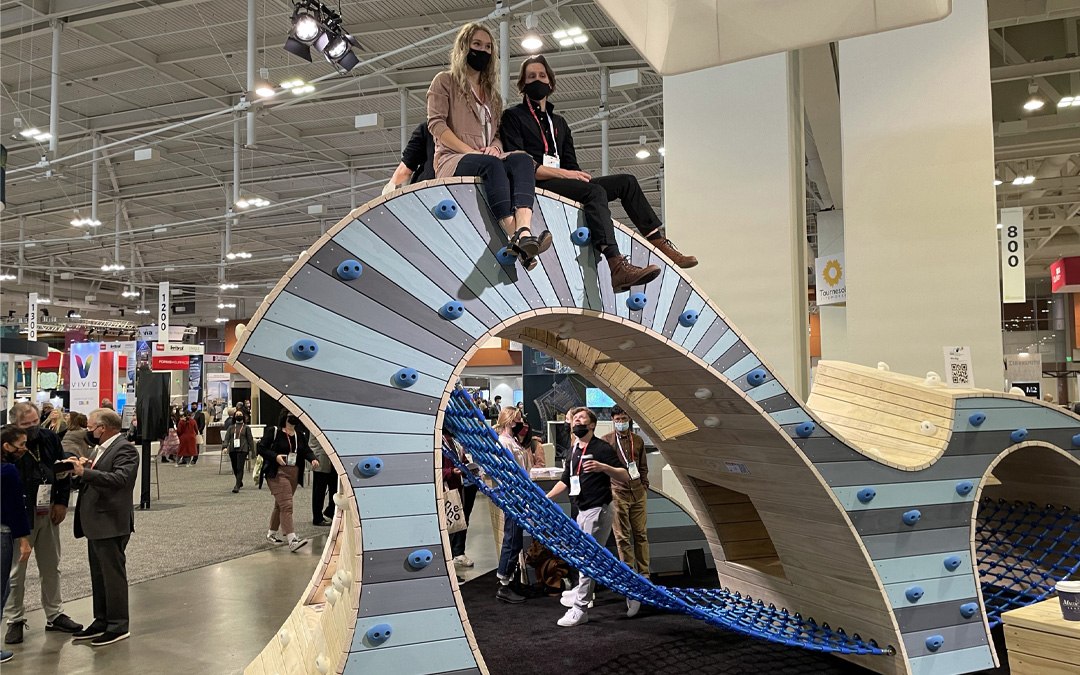
Image: Earthscape
3. Exposure to New Ideas and Trends: The ASLA Conference features keynote speakers, exhibitors, and thought leaders who share their insights into the latest trends and developments in landscape architecture and related disciplines. It’s an opportunity to gain inspiration from visionary projects, innovative design concepts, and sustainable practices. Exposure to these ideas can stimulate creativity and encourage you to incorporate new approaches into your own work.
Pro Tip: Download the Conference app ahead of time to pick your sessions and have a plan (Apple | Google)
4. Professional Recognition: Attending the ASLA Conference can enhance your professional profile and credibility within the industry. By actively participating in conference activities, you demonstrate your commitment to the field and your dedication to ongoing education and networking. This can lead to greater recognition among peers, potential employers, and clients, potentially opening up new career opportunities.
Pro Tip: Stop by the “Emerging Professional Zone” in the Expo to visit the Land8 booth (exciting news to share there), learn about the student LABash Conference, LARE Prep, and more! “JobLink” with hiring firms is right next door too!
The ASLA Conference offers networking, learning, inspiration, and professional development opportunities that can greatly benefit those in the landscape architecture profession. Whether you’re a seasoned professional or a student looking to enter the field, attending the conference can be a valuable investment in your career.
New Partnership with ASLA
Happy New Year! We have exciting news to share!
Over the last few months, Land8 has been working on a strategic partnership with the American Society of Landscape Architects (ASLA) that will bring more features and better content for readers and provide opportunities for Land8 to grow in new ways.
Land8 was founded in 2008 by emerging professionals of ASLA as Land8 Lounge, the social network for landscape architects, and it has grown to become one of the top five resources for landscape architects online. And that’s not even mentioning the events and legendary parties.
So why partner with ASLA now?
First, ASLA can provide financial, technical and administrative support that will help grow Land8. Second, Land8 partnership can provide ASLA an expanded ability to raise awareness of the profession through Land8’s 20,000 international and domestic subscribers and nearly 1.5 million social media followers.
On the surface, not much will change. I’ll remain as the editor of Land8 and oversee the news, unique perspectives, and community. Land8 will remain an open and accessible space where landscape architecture-focused content is curated and exchanged between readers. Now, this partnership will mean more content, richer engagement, and lively communication to the broader landscape architecture community and interested supporters who share our values.
Land8 firmly believes, particularly with ASLA’s new vision, that working together will advance our shared missions of promoting the work of landscape architects to a global audience. If you have ideas or thoughts on how Land8 could build on this new partnership, please don’t hesitate to get in touch.
About ASLA
Founded in 1899, the American Society of Landscape Architects (ASLA) is the professional association for landscape architects in the United States, representing more than 15,000 members, with 48 chapters in 50 states and the District of Columbia. Landscape Architects lead the planning, design, and stewardship of healthy equitable, safe, and resilient environments. ASLA’s mission is to empower our members to design a sustainable and equitable world through landscape architecture. A leader in environmental sustainability, ASLA is headquartered in a state-of-the-art facility designed to achieve LEED Platinum and WELL Building Gold standards, located in the Chinatown neighborhood of Washington, DC.
About Land8
Founded in 2008, Land8: Landscape Architects Network is the social network for landscape architects with 20,000 user profiles. Landscape architects use Land8 as a resource to read articles, ask questions to the community of users, find jobs, research, view design inspiration, network, and access resources. In 2019, Land8 began advising and providing administrative support to the LABash Conference, the annual student-led conference for landscape architecture students in North America that was started in 1970.
Landscape Architecture, Media, and NJASLA
“Frederick Law Olmsted is rightly remembered as an eminent landscape architect, but in 1861 it was his work as a journalist and an administrator that brought him acclaim.” (New York Times)
That’s right, even Olmsted knew the power of journalism and media to advance the causes he would champion, particularly his antislavery views. This year, at the New Jersey Chapter of the American Society of Landscape Architects (NJASLA) Annual Meeting, the theme is “The Legacy of Olmsted: Landscape, Advocacy and Communication”. This theme recognizes the accomplishments of Frederick Law Olmsted beyond the landscape, including his commitment to advocacy in the public realm and as a journalist. The various education sessions, both in-person and virtual, explore this same multi-disciplinary approach as landscape architects work towards defining the built environment for a better future.
So, how do we take cues from Olmsted and others to use media platforms to advance the profession of landscape architecture? Land8 will be moderating a panel entitled “Expanding the Reach of Landscape Architecture Through Media” that will present media, journalism, and advocacy as tools to promote, encourage, and advance landscape architecture. Olmsted utilized journalism to grow his influence and advocate for the ideas he championed, and landscape architects today can use an even wider media ecosystem to promote their work and engage in topics that are important to them. The panel will explore best practices in media relations and discuss the developing trends for content that media outlets and audiences want to view. Further, the panel will challenge landscape architects to raise their voice, promote their work, and become involved in issues that affect their practice and the health and safety of their communities and planet. Whether it’s advocating for the use of native plants, fighting for social justice, or anywhere in between, the panel will demonstrate the imperative for landscape architects to use their design and their voices for change.
The panel will be moderated by Matt Alcide, editor of Land8 with panelists Jennifer Reut, Editor of Landscape Architecture Magazine; Ren Miller, Editor in Chief of Design NJ; and Inga Saffron, journalist and architecture critic for the Philadelphia Inquirer.
The NJASLA 2022 Annual Meeting will be held both in-person and virtually. The physical event will be held in Atlantic City, NJ from January 30 through February 1, 2022. The virtual and on-demand events will be held February 22 – April 26 (dynamic, on-demand platform featuring the recorded sessions from the in-person conference; available for viewing through April 26.)
Register for the in person and virtual event here >
Frederick Law Olmsted’s 1859 Letter Describing Vision for Central Park
Frederick Law Olmsted is known as the “father of landscape architecture.” His most famous work is his co-design of Central Park in New York City, which was established in 1857.
The following letter was written while Olmsted was Superintendent of Central Park and was managing the construction of the open space he designed. The letter requests volunteer participation from a local musician to help draw the public to the city’s most famous green space. In the letter, Olmsted describes his social perception, tremendous commitment to egalitarian ideals, and how these beliefs translate to his obligation to provide managed open space for passive recreation and enjoyment, particularly for those who do not have the means to leave the city environment.
Olmsted famously advocated that “common green space” must always be available to everyone and was to be defended against private encroachment. These principles are now considered fundamental to the idea of a “public park,” but was considered groundbreaking thinking in 1859.
Olmsted’s 1859 letter was composed on Central Park stationery and was embossed “Office of the Arch’t in Chief / CENTRAL PARK / 5th Avenue and 79th St.” and reads:
“It is proposed to provide by subscription a band of music upon the finished portion of the park for a few hours during one or two afternoons a week, for the purpose of increasing its immediate value to those who cannot leave the city. It is believed that after this year the Commissioners of the Park will be able to furnish the means for this purpose without drawing upon their construction fund, but their arrangements cannot be completed at present without the aid of voluntary contributions from citizens who will be influenced by motives of kindness toward those who have no means to go into the country for relief from the heat and turmoil of the city. [Signed] Fred. Law Olmsted. / Superintendent.”
The handwritten letter will be auctioned by Nate D. Sanders Auctions on December 13, 2018. Bidding for Olmsted’s letter begins at $35,000.
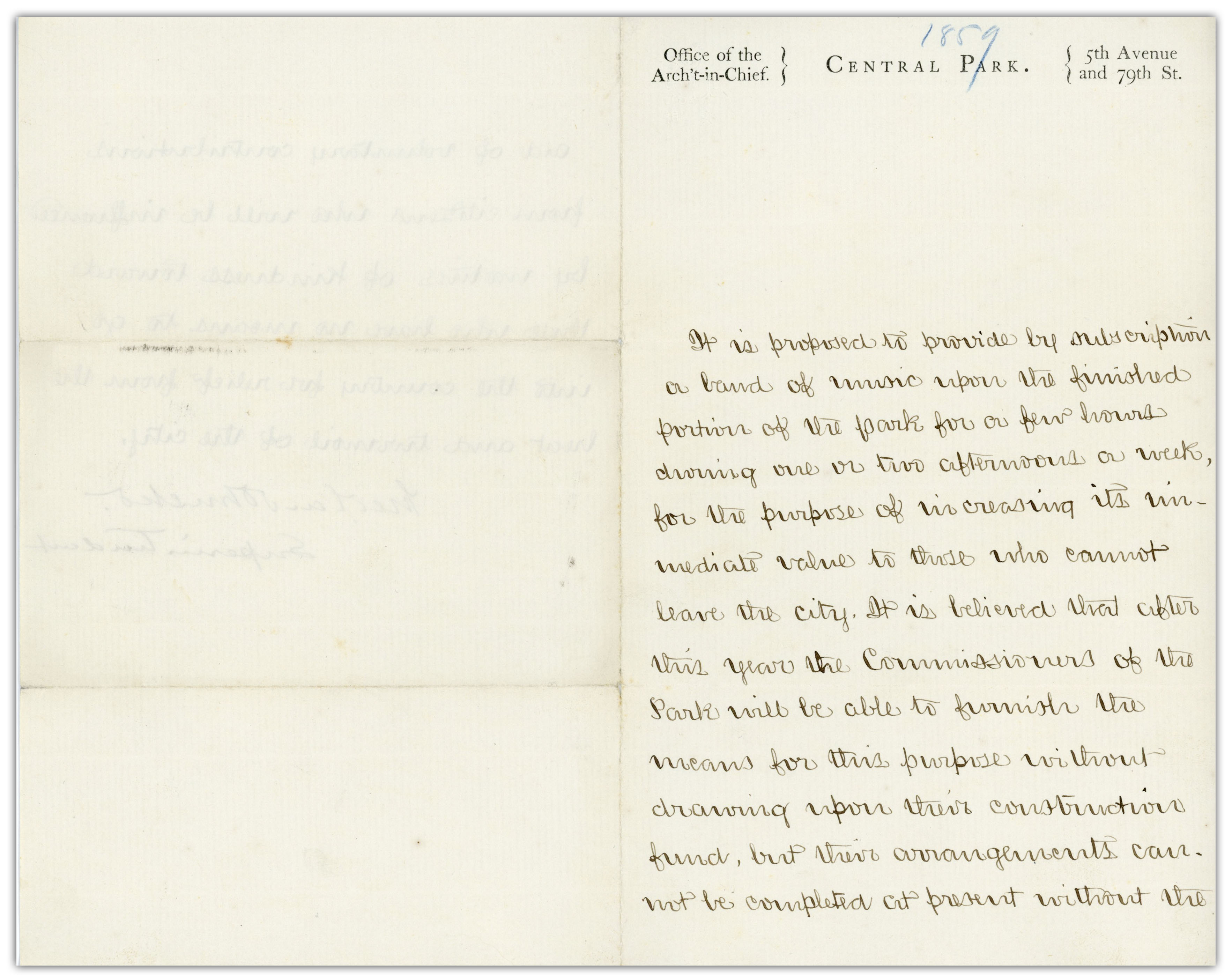
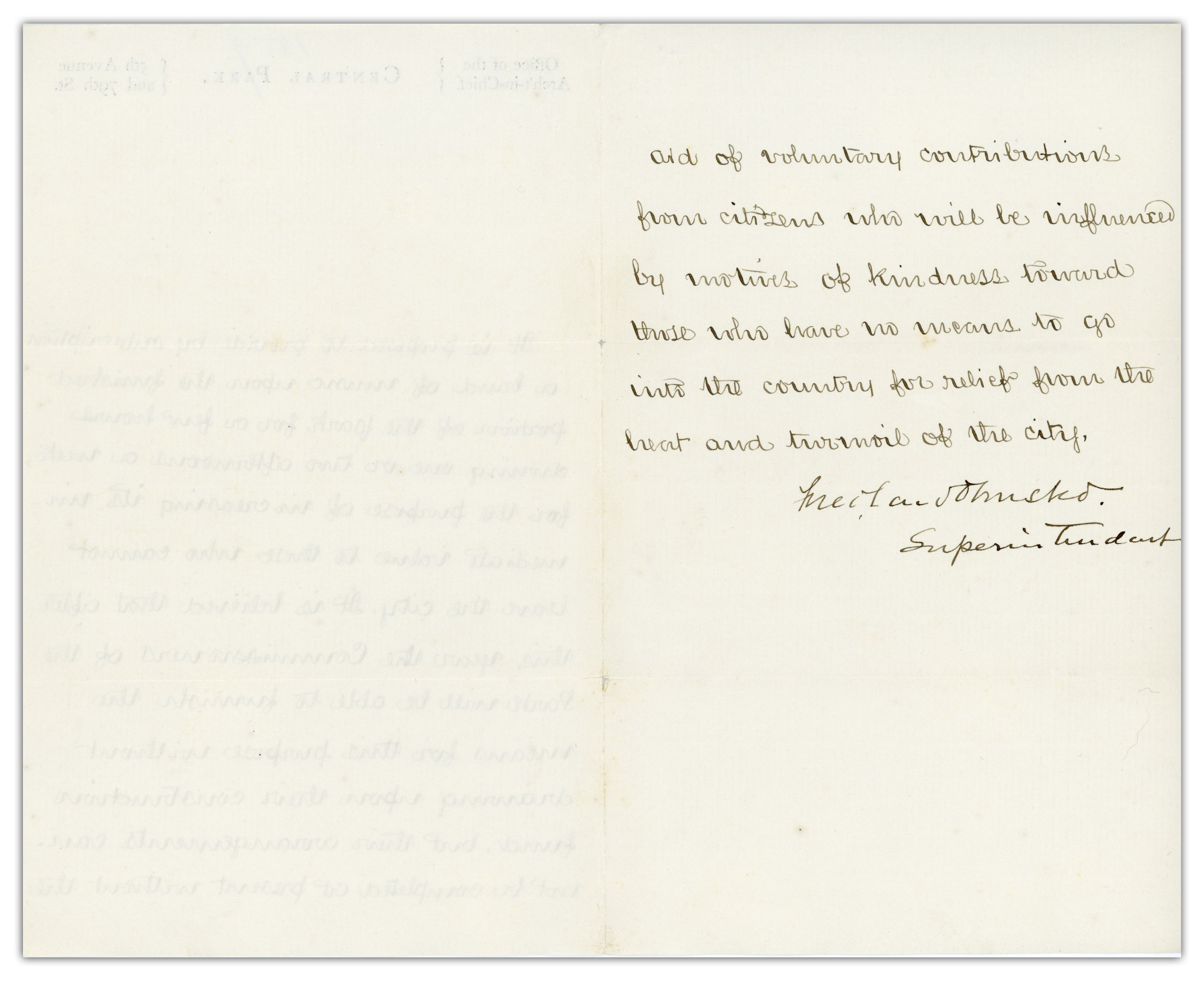

An Urban Forest for Shanghai
Global cities are in the midst of an unprecedented shift as more people are choosing to live in urban areas than ever before. More housing, transportation, and public services are needed to support cities’ growing populations, which can have negative impacts on air and water quality, and residents’ access to natural environments. In addition, climate change is creating new realities like urban hot spots and rising sea levels, demanding more creativity out of planners who must make sure urban areas are livable. In response, cities around the world are investing in public green spaces and waterfronts on impressive scales, as easy access to these spaces is becoming a requirement of urban livability.
International design studio HASSELL has made this new reality a primary focus, designing some of the world’s most loved places that also meet the needs of today. From Sydney’s Darling Harbour, to South San Francisco’s Colma Creek, their expertise in waterfront design stands out. Most recently, HASSELL was awarded an International Architecture Award for their approach to Shanghai’s Huangpu River waterfront.
In Shanghai, the Huangpu River is lined with ferry docks, commercial buildings, a cement plant, and construction sites. To reconnect residents to the waterfront and improve urban livability, HASSELL proposed creating the world’s largest urban forest along the east bank of the Huangpu River, winning the International Architecture Award for their concept.
HASSELL Principal Richard Mullane, who led the Huangpu project and now serves as a principal in the practice’s San Francisco studio said, “Understanding that cities and their surrounding environments are constantly changing, we asked ourselves: How can we plan a waterfront today that future generations will still be able to use? By designing flexible, adaptive features we could ensure that no matter how Shanghai changes, residents will always have access to the natural, recreational spaces they need.”
The design was completed as part of an international competition held by the Shanghai government to reimagine and redesign 21 kilometers along the river’s edge.

Image: HASSELL
‘Huangpu East Bank Urban Forest,’ a HASSEL concept, detailed a continuous woodland of two million trees – one tree planted for each of Shanghai’s two million children. While it is estimated that the project would take 20 years to complete, HASSELL noted that the children represented by the forest would grow with it, coming of age at the same time of the project’s completion.
To give Shanghai’s young population a sense of ownership over their city and the project, HASSELL envisioned people in the community as the creators of the space. Their proposal features a series of tree planting events, allowing local schools to participate in the creation and custodianship of the forest. The plan also contains a series of multi-functional event spaces, so that the community could host a wide variety of cultural gatherings.
Specifically, the urban forest would contain a multitude of different destinations, ranging from large, dramatic event spaces, to sporting facilities for locals, outdoor classrooms, libraries, and cafés. A system of elevated walking loops would help overcome industrial and transportation barriers along the waterfront that had previously restricted public access.
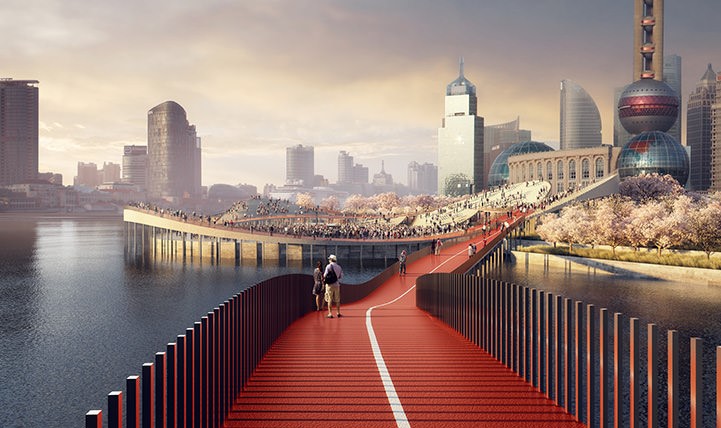
Image: HASSELL
“To make sure current and future generations of residents could enjoy the waterfront, we felt that we needed a design that could adapt to the ever-evolving needs of an expanding society. While we can design the landscape, the community will ultimately bring the space to life, so it must be able to accommodate a variety of cultural activities,” said Richard.
This design approach is taking hold worldwide. In the San Francisco Bay Area, Resilient by Design used a similar community-based approach for a design challenge, in which HASSELL also participated. The year-long program combined the expertise and experience of residents, public officials and local, national and international experts to come up with community-based solutions to the sea level rise, severe storms, flooding and earthquakes that threaten communities throughout the Bay Area.
Before it became known as the Bay Area’s ‘industrial city’, the residents of South San Francisco could walk the length of nearby Colma Creek and swim in the San Francisco Bay. However, industry limits access to the shoreline and sea level rise fueled by climate change causes widespread and damaging flooding.
Through community engagement, research, and an inclusive design process, HASSELL’s international collective mapped out a range of ways to strengthen the city of South San Francisco from the effects of climate change. The final proposal restores public access to the waterfront, establishes more open green spaces and parks, and creates continuous public access along Colma Creek. HASSELL’s Resilient South City plan addressed the impacts of climate change that the community will face in the coming decades.
Richard, who also lead HASSELL’s Resilient South City proposal said, “We heard from local residents that they really felt that their historic connection to the water was lost, and with sea level rise threatening to restrict access even further, we knew our design had to be multi-purpose, to both connect people to nature and address future environmental changes.”
To achieve this dual purpose, HASSELL’s design included:
- A wider, greener creek that would manage flooding and create the right conditions for a sequence of new parks on either side.

Image: HASSELL
- A new South City Circle Bridge that would serve as a walking and cycling gateway between the city and the train stop nearby, and a native plant nursery just below the bridge to help control flooding and treat runoff from the nearby highway, improving the quality of water flowing into the creek and Bay.
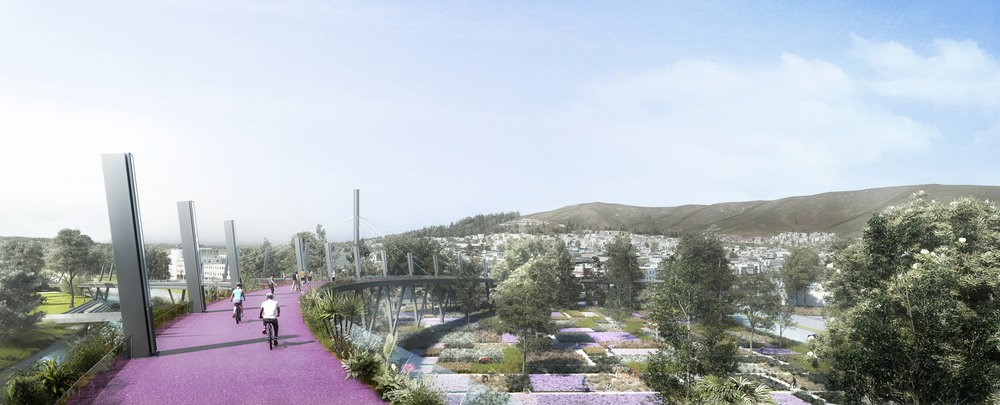
Image: HASSELL
- And an ‘eco waterpark’ at a revamped, natural water plant, which would not only improve water quality but also become a teaching tool and natural shoreline swimming pool for the community to enjoy.
Cities around the world are investing in public green spaces and their longevity is determined by their ability to be adaptable and serve a multitude of purposes. In Shanghai, a waterfront is not just a walking path, but a series of cultural event venues for gatherings large and small. In South San Francisco, a park isn’t just a place to play and enjoy nature, but a way to manage flooding and improve water quality. By listening to the needs of the local communities, designers and architects are creating spaces that can be enjoyed by the generations of today and tomorrow.
- 1
- 2


